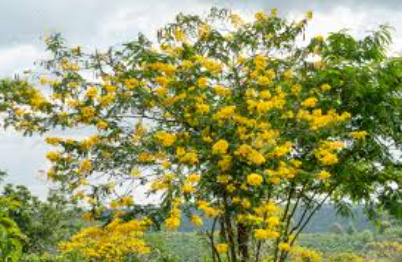Senna spectabilis (GS Paper 3, Environment)

Introduction
- Environmental groups in Wayanad have raised concerns over the Forest Department's approach to managing Senna spectabilis, an invasive species threatening the native habitats in the Nilgiri Biosphere.
- This article delves into the background, impact, and ongoing efforts to control this species, highlighting the need for rigorous standards and transparency in removal practices.
Background and Impact of Senna spectabilis
- Senna spectabilis, also known as Cassia spectabilis, is a deciduous tree native to tropical South America.
- Initially introduced for its ornamental value and shade-providing capabilities, it has become a significant environmental issue in various regions, including the Wayanad Wildlife Sanctuary.
- This species is known for its rapid growth and allelopathic properties, which inhibit the growth of native plants, leading to reduced biodiversity.
- The invasive nature of Senna spectabilis disrupts the local ecosystems by outcompeting native flora, altering habitats, and affecting the availability of resources for native fauna.
- Its presence in Wayanad Wildlife Sanctuary poses a threat to the ecological balance and the well-being of indigenous wildlife.
Intervention Strategies
- The Forest Department initially employed mechanical methods such as uprooting and girdling to eradicate Senna spectabilis.
- However, these methods proved ineffective as they often resulted in the proliferation of coppice shoots from the stumps.
- Additionally, inconsistencies in timber handling and pricing across different forest divisions raised concerns about the fairness and efficiency of these interventions.
Proposal for Controlled Removal
- Badusha, President of the Wayanad Prakruthi Samrakshana Samithi, emphasized the recent agreement with Kerala Paper Products Limited (KPPL) to acquire 5,000 tonnes of Senna spectabilis at a reduced price compared to other regions.
- He advocated for the establishment of a Standard Operating Procedure (SOP) to ensure that the removal process does not further harm the environment.
Need for Rigorous Standards and Transparency
- Activists and environmentalists point to the practices in other reserves like Muthumalai and Sathyamangalam, where extraction is regulated by stringent guidelines.
- They urge the implementation of a similar, well-researched strategy in Wayanad.
- Developing a detailed SOP is crucial for the safe and effective removal of Senna spectabilis, minimizing the impact on local wildlife and habitats.
About Senna spectabilis
- Native and Invasive Nature: Senna spectabilis is native to tropical South America and has become invasive in parts of Africa and Asia, disrupting native ecosystems.
- Medicinal Uses: Despite its invasive status, it is valued for its medicinal properties, particularly in treating constipation and skin diseases.
- Ecological Benefits: The tree’s bright yellow flowers provide nectar for bees, and it is utilized in reforestation projects on degraded lands.
Conclusion
- The management of Senna spectabilis in the Wayanad Wildlife Sanctuary underscores the complexities of balancing ecological preservation with practical intervention strategies.
- While the tree poses significant threats to local biodiversity, its controlled removal, guided by rigorous standards and transparent practices, is essential.
- Collaborative efforts between environmental groups, the Forest Department, and other stakeholders will be crucial in safeguarding the sanctuary’s ecological integrity.


